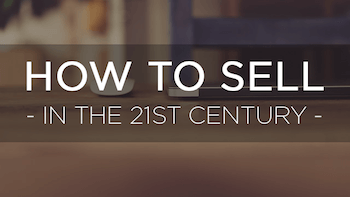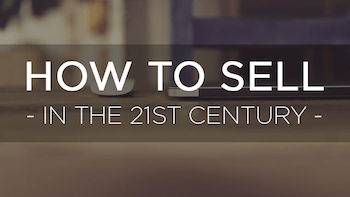How to sell in the 21st Century
“In the age of the Internet, caller ID, and email, how do we sell? How do we reach prospects in a way that will convince them to work with our firm? I don’t think we can just go bang on doors anymore, but I’m not sure what to do instead…”
On the one hand, the Internet has changed everything. When my career in sales started, the sales person had all the information. If you wanted to be educated about the products or services they sold you had to sit and listen to their spiel. The sales people were in control of the process.
Now, not so much. Much of the information you would want to know about just about any product or service is available through a simple web search. If not on your website, then on your competitor’s site! Buyers are spending more of their time researching before they ever talk to a sales person, and most of that time they are invisible to you! You don’t even know that they are shopping.
But despite all this change – there are some fundamentals that remain the same. People are still people; and people like to buy from folks that they know, like and trust. So if, during their shopping process, you are someone they can get to know – who’s likable, and trustworthy – then you are going to make it more likely that they call you when they are ready to buy.
How do you become someone who’s known, liked and trusted, on the internet?
1. Be helpful. Teach. Share information
The number one best way to sell in the 21st century is to be helpful. Your prospect is on a quest – in search of the solution to their problem. Most likely you are that solution, but they haven’t figured that out yet! So anything you can do to help them along in their journey will make you someone they like and trust!
How can you be helpful?
- Create blog posts answering the most common questions that you get from prospects. If people are asking you these questions face-to-face, your invisible customer wants that information too.
- Use your website to teach your prospects as much about your product or service as you can.
- Tell stories about the challenges your clients are facing – and how your product or service has helped them. Make the client the hero of that story.
- Show them how the sausage is made. How can you go behind the scenes to show how your product is created, or to show how you develop your service offerings?
2. Show some personality
People’s trust of companies to “do the right thing” is at an all time low. The more “corporate” your website looks and feels, the less likely it is that anyone is going to engage with your company at all! So show some personality! This is a place where small companies have a real advantage over bigger companies. It’s easier to get to know the leaders of a small company. Your values are (likely) the company values. So put your face on it – let folks know that this is your company and that you are standing behind it.
When we show more personality it makes us more likable. Yes, there are going to be some people who don’t like your personality, but they wouldn’t be very good customers for you anyway! So put it out there. Let folks know where you stand; they will like you and trust you more.
3. Get out into the world and meet people
No matter how much personality you show on your website nothing beats getting face to face! It’s impossible to estimate the amount of goodwill generated by just being in the same space with someone; by having a meal and chatting.
- Go to your industry conferences (or better yet, speak at one)
- Go to your client’s industry conferences (definitely speak at those, with your client on the podium with you)
- Get involved with a local networking or roundtable group
- Pick up the phone and call some prospects, not to sell to them, just to be helpful.
- Spend some time working for a cause that you are passionate about. Get on a board, or just volunteer.
Whatever you need to do in order to meet folks face-to-face, do it (and if you have a chance to be helpful, take it). Do it now.
4. Go deep – Offer more comprehensive information
Answering questions on your blog is really great. It’s important to be helpful, but at some point you need folks to stop being anonymous. You want them to raise their hand, and be recognized. To get that to happen you need to bring out the big guns. What are the things that you know how to do better than anyone? What is your superpower? Whatever that is, you want to capture that in an offer. An offer is something of value that you are willing to provide your prospect, something that they will value enough that they will give you their contact information in order to obtain it. Ideally you would have a number of different “offers” that would suit different types or prospects or problems that you might be able to solve. Those might look like:
- A Webinar that goes deeper into one key area that prospects need to know in order to get the most value from working with a professional like you.
- An eBook that explains the process that you would go through if you were shopping for the service you offer.
- A series of videos that teach your customer things that they need to know in order for them to be more successful.
- One of your best customers laying out step-by-step how they solved this problem (with your help).
These should not be sales pitches; you are still just being helpful. Remember, you want them to know, like and trust you. That’s not going to work if you bait and switch folks into a sales pitch!
5. Sales are closed human-to-human
Eventually you need to get on the phone, or better yet, face-to-face with your prospect to understand their problem and show them how you can fix it. This is still not a pushy, “Buy Now” sales conversation. Instead, you are looking to help understand their problem – why are they searching for this information?
Maybe a conversation would go something like this:
YOU: “Hi, I noticed you’ve downloaded our e-book, I just wanted to reach out and make sure it’s been helpful to you. Was it? What questions did it answer for you, and what questions were still left unanswered?”
THEM: “Oh yes, it was very helpful. It brought to mind a number of things we hadn’t considered…”
YOU: “What sort of issues are you experiencing that sent you out searching for this information? Do you mind telling me a little about your situation?”
At this point you are in a typical discovery conversation where you are helping them to understand their problem, the implications of that problem, and eventually the ways that you can help them solve it!
The more things change the more they stay the same. We still sell services by being the provider that people know, like and trust; but now we have all these new tools that we can use to find our prospects, get in front of them, demonstrate our expertise, and build trust. How will you use these tools?

Photo credit: Scooter Lowrimore

Interested In having Brad speak at your next event?
Let’s talk.
"*" indicates required fields

